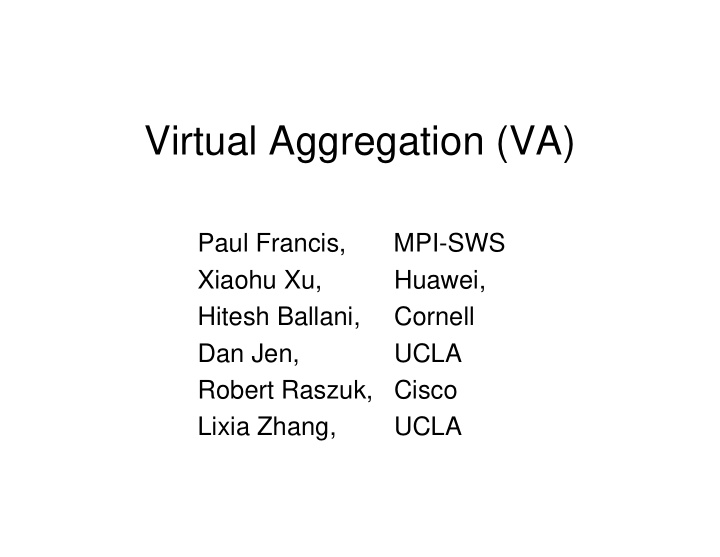



Virtual Aggregation (VA) Paul Francis, MPI-SWS Xiaohu Xu, Huawei, Hitesh Ballani, Cornell Dan Jen, UCLA Robert Raszuk, Cisco Lixia Zhang, UCLA
Summary • No new technical material • Consolidation and simplification of drafts • We consider drafts now to be “stable” • Future: – Expect only minor changes based on lessons learned from implementation and deployment Los Angeles IETF, Mar. 2010 2
Current drafts • Current drafts: – draft-ietf-grow-va-02 – draft-ietf-grow-simple-va-00 – draft-ietf-grow-va-auto-01 • Deprecated drafts: – draft-ietf-grow-va-mpls-innerlabel-00 – draft-ietf-grow-va-gre-00 – draft-ietf-grow-va-mpls-00 – All simplified and folded into draft-ietf-grow-va-02 Los Angeles IETF, Mar. 2010 3
draft-ietf-grow-va-02 • Removed some tunnel types – GRE, use of per-external peer IP tunnels • Remaining tunnel types: – IP or MPLS – Both with or without inner label – Note: • with inner label, BGP next hop is local ASBR, • without inner label, BGP next hop is remote ASBR Los Angeles IETF, Mar. 2010 4
draft-ietf-grow-va-02 • Regarding uRPF (Jarad raised in Hiroshima) – For strict uRPF, local ASBR can do it, but must FIB- install routes where peer remote ASBR is next hop • Good idea to do this anyway, for efficient paths – Loose uRPF can only be done at Aggregation Point Router (APR) • Same for martian filters, etc. • Silver lining: VA allows lower-tier ISPs that today default route everything to providers, to now do RPF, martian filtering, etc. Los Angeles IETF, Mar. 2010 5
draft-ietf-grow-simple-va-00 • Simple VA = “Raszuk mode” VA – Core routers keep full FIB, edge routers do FIB suppression, otherwise default 0/0 to core – Virtually no configuration • Simply moved text for this from main draft to separate draft – 11 pages total (5 substantive pages) – Very easy to understand and digest for vendors and customers only interested in this mode Los Angeles IETF, Mar. 2010 6
draft-ietf-grow-va-auto-01 • 00 version discussed several variants of auto- configuration • 01 version has only one: – “Can suppress” tag – In a nutshell, effectively limits configuration to local ASBRs that peer with provider ISPs • Why this version? Because Huawei is implementing it – Can revisit other variants if the market suggests a need Los Angeles IETF, Mar. 2010 7
draft-ietf-grow-va-auto-01 • Requires a new extended communities attribute – Does this suggest that it should be standard rather than informational? Los Angeles IETF, Mar. 2010 8
Next steps? • Continue work on interoperable implementations – Use experience to tweak drafts • Otherwise, anything else needed to move to RFC? Los Angeles IETF, Mar. 2010 9
Recommend
More recommend